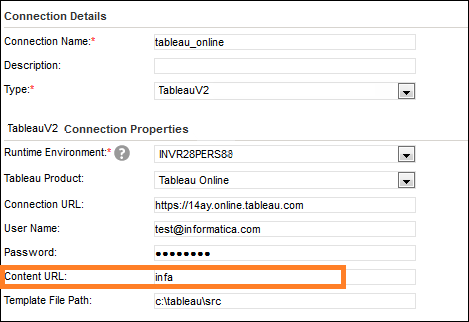Tableau V2 Connection Properties
When you set up a Tableau V2 connection, you must configure the connection properties.
The following table describes the Tableau V2 connection properties:
Connection Property | Description |
|---|
Runtime Environment | The name of the run-time environment where you want to run the tasks. |
Tableau Product | The name of the Tableau product to which you want to connect. You can choose one of the following Tableau products to publish the TDE file: - - Tableau Desktop. Creates a TDE file in the Secure Agent machine. You can then manually import the TDE file to Tableau Desktop.
- - Tableau Server. Publishes the generated TDE file to Tableau Server.
- - Tableau Online. Publishes the generated TDE file to Tableau Online.
|
Connection URL | URL of Tableau Server or Tableau Online to which you want to publish the TDE file. The URL has the following format: http://<Host name of Tableau Server or Tableau Online>:<port> |
User Name | User name of the Tableau Server or Tableau Online account. |
Password | Password for the Tableau Server or Tableau Online account. |
Content URL | The name of the site on Tableau Server or Tableau Online where you want to publish the TDE file. Contact the Tableau administrator to provide the site name. |
Template File Path | The path to a sample TDE file from where the Secure Agent imports the Tableau metadata. Enter one of the following options for the template file path: - - Absolute path to the TDE file.
- - Directory path for the TDE files.
- - Empty directory path.
The path you specify for the template file becomes the default path for the target TDE file. If you do not specify a file path, the Secure Agent uses the following default file path for the target TDE file: <Secure Agent installation directory>/apps/Data_Integration_Server/<latest version>/bin/rtdm |
Content URL
You can specify the name of the content URL to point to a specific site on Tableau Server or Tableau Online where you want to publish the TDE file. Specify the site name in the connection properties.
The content URL has the following format: http://<Host name of Tableau Server or Tableau Online>:<port> /#/site/<Name of the content URL>/View in Tableau Server or Tableau Online>
For example, if you create a site called infa on Tableau Server, the content URL for the site on Tableau Server is: https://10.50.100.100:6000/#/site/infa/workbooks
The value you specify for the content URL in the connection properties is Infa.
The following image shows the connection properties with the specified content URL property:
To specify an existing content URL site name on Tableau Server or Tableau Online where you want to publish the Tableau data extract, contact the Tableau Server or Tableau Online administrator.
Template File Path
When you create a Tableau V2 connection, you can specify the path to a sample TDE file from where the Secure Agent imports the Tableau metadata.
The Secure Agent generates the target object TDE file from the source object based on the data representation in the specified Tableau template file. The path you specify for the template file in the connection properties becomes the default path for the generated target TDE file.
You can use one of the following options for the template file path:
- Absolute path to the TDE file
- Enter a directory path along with the TDE file name. For example, enter the following absolute path to a TDE file: C:\tableau\abc.tde
- When you configure a Data Synchronization task or Mapping Configuration task, the TDE file appears in the target object list. Use the template .tde file to fetch the Tableau metadata.
- Directory path for the TDE files
- Enter a directory path that contains the TDE files. For example, enter the following directory path: C:\tableau
- When you configure a Data Synchronization task or Mapping Configuration task, the TDE files that are available in the specified directory appears in the target object list. Select a template .tde file to fetch the metadata from that file.
- Empty directory path
- If you do not want to use a template file, enter an empty directory path. For example, enter the following directory path: C:\tableau
- When you do not use the template file to create a target object, you can create a target by using the Create Target option in a Data Synchronization task or Mapping Configuration task. You need to select the source fields that you want in the target TDE file and provide a name for the target object TDE file. The Secure Agent creates a target TDE file in the specified location. If you do not specify a name and directory path for the target TDE file in the connection properties, you can provide the extract file path and file name for the target TDE file in the advanced properties of the Data Synchronization task or Mapping Configuration task.

